 |
 |
 |
|
|||
|
Portrait of a Marriage Festival
When you first arrive here, what strikes you are the throngs of people. Bus loads arriving every minute. Berber men, women and children ferried in on the backs of lorries. Many of the women are veiled and wearing traditional dress; the men often wear keshdools, those long cloths wrapped like turbans around the head and face. They're great for keeping out the ever-present dust from the eyes and mouth.
Nearby, there is a hillside, covered with domestic animals, and a brisk trade is underway and herders replenish their supply of sheep, goats and donkeys. For the nomadic Berbers, spending most of the year tending flocks or farming left few opportunities for people of marriageable age to find each other. So in its early days, the marriage moussem became a kind of one-stop shopping opportunity for those seeking a mate. You could supposedly meet, become engaged and celebrate your marriage, all in a week's time. And when Moroccans celebrate, it's with the kind of music that it's hard to sit still for. There's a legend among the Ait Haddidou Berbers, which tells of a pair of young lovers who belonged to different warring factions of the tribe. With their marriage strictly opposed, the lovers, in desperation, committed suicide. The tears that were shed for them filled two lakes -- the lake of the bride and the lake of the groom, located not far from where the marriage is now held. With this cautionary tale in mind, all prospective newlyweds are said to visit the tomb of a local holy man, who became famous for blessing successful marriages. During the moussem, just outside the tomb, members of a sufi brotherhood chant, dance, drum, and play the graita, the horn, throughout the day. Westerners sometimes label this as a kind of trance music. And considering that in a blistering heat, these men were able to dance and play for hours on end without let up, many with smiles of ecstasy upon their faces, it was indeed as if they were in another state of consciousness. While making this recording, I made a donation to the musicians, and one of the singers, an older man, took of his turban, placed a lit candle on his bald head, and danced for a while with the wax slowly dripping down on him.
Nowadays, most of the Berbers' courtship takes place during the year, with the formalities of marriage, by tradition, occurring during the moussem. Part of the official ceremony has troupes of dancers and musicians playing in a cordoned off arena to an audience of mostly journalists. Although the journalists appear to be largely indifferent to its magic, the music is hypnotic, with currents of passion and exuberance. The dancers perform shoulder to shoulder, weaving their lines back and forth. And although there are steps each line and each individual follows, there is an improvisation too, with the dancers sometimes raising their shoulders in time with the music, sometimes, their knees. You have the sense of a tumultuous frenzy, kept in control by the rigors of the form. The formal music presentation goes on for hours. Informally, there's music in the tents of the encampment all through the night. And it's in that music that you can feel the real spirit of Morocco appear, available to one and all, whether tourist or Berber, like a long drink of fresh mint tea. For a moment, at least, we all become members of the wedding party. This year's marriage festival runs from September 18-21. For details on tours to the festival and other Moroccan venues, visit the Sarah Tours website or contact them by phone at (800-267-0036).
|
 | American Public Media Home | Search | How to Listen ©2004 American Public Media | Terms of Use | Privacy Policy |
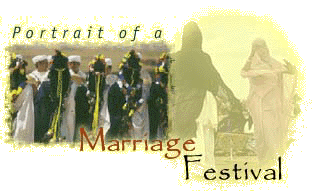
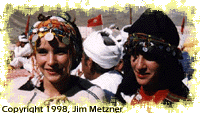
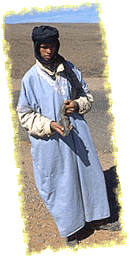 If you look at an aerial view of Morocco, it resembles a portrait in profile, with the Atlas Mountains like a collar separating the head (the coastal and fertile plains of the country) from the torso (the more arid and desert regions). The village of Imilchil is nestled between the Middle and High Atlas, and the terrain resembles much of rural Mexico and the Sierra Nevada, a mixture of prairie and pasture, dry scrub and barren hillside.
If you look at an aerial view of Morocco, it resembles a portrait in profile, with the Atlas Mountains like a collar separating the head (the coastal and fertile plains of the country) from the torso (the more arid and desert regions). The village of Imilchil is nestled between the Middle and High Atlas, and the terrain resembles much of rural Mexico and the Sierra Nevada, a mixture of prairie and pasture, dry scrub and barren hillside.
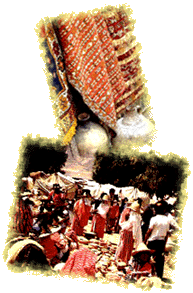 The moussem takes place amidst an enormous encampment, surrounded by the hills of this arid region. There are limited accommodations some twenty to thirty miles away, similar to a youth hostel. If you're staying on the site, you'll be sleeping in a tent. And there are tents of every description, along with gas generators cranking out electricity, stalls selling food and trade goods, and tourists, mostly Europeans, dutifully photographing everything in sight. One whole area of the encampment is given to clothing sellers. Picture piles of coats, pants, shirts, some new, some second-hand, and in the middle of them, standing on chairs or tables are hawkers, building up a selling frenzy.
The moussem takes place amidst an enormous encampment, surrounded by the hills of this arid region. There are limited accommodations some twenty to thirty miles away, similar to a youth hostel. If you're staying on the site, you'll be sleeping in a tent. And there are tents of every description, along with gas generators cranking out electricity, stalls selling food and trade goods, and tourists, mostly Europeans, dutifully photographing everything in sight. One whole area of the encampment is given to clothing sellers. Picture piles of coats, pants, shirts, some new, some second-hand, and in the middle of them, standing on chairs or tables are hawkers, building up a selling frenzy.
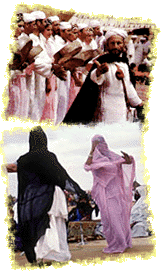 Now somewhere amongst the throngs of people, perhaps inside of the many tents here, the matters of courtship and marriage are being conducted. But the typical visitor won't see it. Efforts to promote this event to foreign tourists have driven much of its charm and authenticity underground. The closest the casual visitor gets to seeing the marriage ceremony is the moment when a dozen brides and grooms are trotted out onstage for the members of the press to have a look at. The men, mustached and handsome are wearing white dhellabahs (hooded robes), and the women are wearing blanket-like robes over white dresses. They are hooded and veiled, shy, mysterious, and when one catches a glimpse of a face, quite beautiful. Although there are some smiles, it's an awkward moment -- how would you feel on a stage at your wedding, with several thousand strangers showing up?
Now somewhere amongst the throngs of people, perhaps inside of the many tents here, the matters of courtship and marriage are being conducted. But the typical visitor won't see it. Efforts to promote this event to foreign tourists have driven much of its charm and authenticity underground. The closest the casual visitor gets to seeing the marriage ceremony is the moment when a dozen brides and grooms are trotted out onstage for the members of the press to have a look at. The men, mustached and handsome are wearing white dhellabahs (hooded robes), and the women are wearing blanket-like robes over white dresses. They are hooded and veiled, shy, mysterious, and when one catches a glimpse of a face, quite beautiful. Although there are some smiles, it's an awkward moment -- how would you feel on a stage at your wedding, with several thousand strangers showing up?